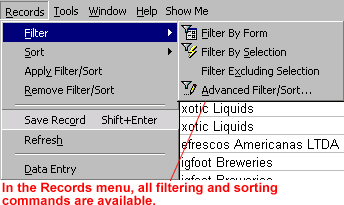Refining Data Exploration: A Deep Dive into Filtering Records in Access 2000

In the intricate world of database management, the ability to filter records serves as a cornerstone for extracting actionable insights, making informed decisions, and ensuring data accuracy. Microsoft Access 2000, a robust relational database management system (RDBMS), empowers users with a myriad of tools and features for refining data exploration through precise record filtering. In this extensive guide, we embark on an exhaustive exploration of filtering records in Access 2000, unraveling various methods, strategies, and best practices to empower users in their data refinement endeavors.
Understanding Record Filtering
Before delving into the intricacies of filtering records in Access 2000, it’s essential to grasp the fundamental concept of record filtering within the database ecosystem. In Access 2000, a record represents a single instance or entry of data within a table. Each record typically comprises fields representing specific attributes or properties of the data being stored. Filtering records involves selectively displaying records that meet specified criteria, such as field values or text patterns, thereby narrowing down the dataset to focus on relevant information.
Methods of Filtering Records
Access 2000 offers users multiple methods for filtering records, catering to diverse preferences and workflow requirements:
- Filtering in Datasheet View: The datasheet view serves as a primary interface for interacting with table records in Access 2000. Users can filter records within the datasheet view by applying filter criteria to one or more columns. Access 2000 allows users to filter records based on various criteria, such as text patterns, numerical ranges, or date values, facilitating quick and targeted data exploration.
- Query-Based Filtering: Access 2000 enables users to perform sophisticated data filtering using queries, providing a versatile approach to data refinement. Users can create select queries and specify filtering criteria using the “WHERE” clause to selectively retrieve records based on specific conditions. By defining precise filtering criteria, users can narrow down the dataset to focus on relevant information and streamline data analysis.
- Advanced Filter/Sort: Access 2000 offers an advanced Filter/Sort feature that allows users to apply complex filtering criteria to datasheets, forms, or queries. Users can specify multiple criteria, combine logical operators, and create custom filter expressions to refine data exploration. The Advanced Filter/Sort feature provides users with a powerful toolset for fine-tuning data filtering operations and uncovering valuable insights.
- Form-Based Filtering: Forms provide users with a structured and user-friendly interface for interacting with data in Access 2000. Users can create custom filter forms tailored to their data refinement requirements, incorporating text boxes, drop-down lists, and other controls for specifying filter criteria. Form-based filtering facilitates intuitive and efficient data exploration, enhancing user productivity and analysis capabilities.
Best Practices for Filtering Records
While filtering records in Access 2000 is relatively straightforward, adhering to best practices can optimize efficiency, accuracy, and data exploration:
- Define Clear Filter Criteria: Before initiating record filtering operations, it’s essential to define clear and specific filter criteria based on the desired data attributes or properties. By articulating precise filter criteria, users can ensure focused and relevant data exploration, minimizing the risk of retrieving extraneous or irrelevant information.
- Utilize Indexes: Leveraging indexes on filtered fields can enhance the performance of filtering operations and improve overall query performance. Access 2000 allows users to create indexes on fields used for filtering, facilitating faster data retrieval and analysis. By optimizing index usage, users can streamline the filtering process and enhance the responsiveness of database applications.
- Refine Filter Expressions: As data exploration progresses, users may need to refine filter expressions to narrow down search results and focus on specific data subsets. Access 2000 provides tools and features for modifying and refining filter expressions, such as adding additional criteria or adjusting logical operators, enabling users to iteratively refine their data exploration based on evolving analysis needs.
- Review and Validate Results: After applying filters, it’s crucial to review and validate the accuracy and relevance of the filtered dataset. Access 2000 allows users to preview filtered results within datasheets, forms, or queries, facilitating visual inspection and validation of the refined dataset. By reviewing filtered results, users can ensure data accuracy and make informed decisions based on the refined information.
Conclusion
In conclusion, mastering the art of filtering records in Access 2000 is essential for efficient data refinement and exploration. By leveraging the diverse methods, strategies, and best practices outlined in this guide, users can streamline the process of filtering records, enhance data exploration capabilities, and unlock the full potential of Access 2000 for effective database management. Whether you’re a novice user or an experienced database administrator, proficiency in filtering records empowers you to navigate the complexities of data refinement with confidence and precision.




